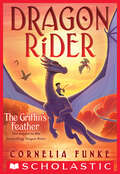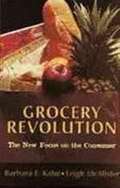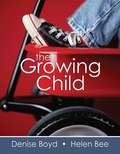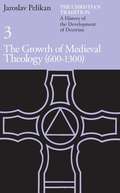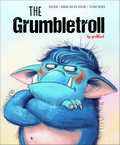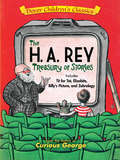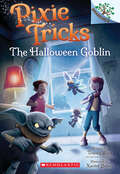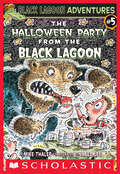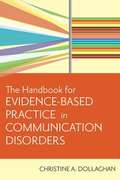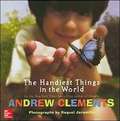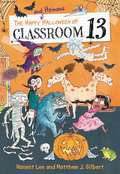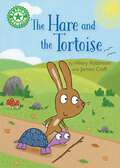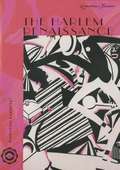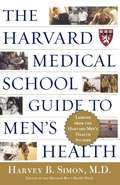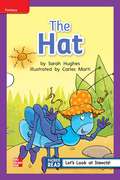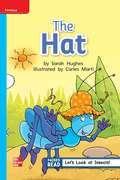- Table View
- List View
The Griffin's Feather (Dragon Rider #2)
by Cornelia FunkeA boy and a dragon team up to keep the Pegasus from extinction in this “not-to-be-missed” sequel to the #1 New York Times–bestselling Dragon Rider (School Library Journal).The last Pegasus in the world has been discovered and when Ben learns the legendary horse has three unhatched eggs that need to be protected, he vows to help. But the only way the eggs will ever hatch—and continue the survival of this incredible magical species—is if they are placed under a griffin’s feather. But griffins are the most dangerous creatures in the world, and their mortal enemies are dragons . . . Ben vows not to tell his beloved dragon Firedrake about his quest, if only to protect him. But as Ben sets off for a remote island where the terrible griffins are rumored to live, he may just need the help of his best friend and dragon . . . “A richly imagined, adeptly illustrated adventure with a strong message of respect for all species of creatures.” —Kirkus Reviews
The Grocery Revolution: The New Focus on the Consumer
by Barbara E. Kahn Leigh M. McalisterThis text provides an introduction to the understanding of changing consumer behaviour and trends in managerial practice in the grocery industry.
The Growing Child
by Denise Boyd Helen L. BeeThe Growing Child emphasizes how the three domains of development -- physical, cognitive, and socio-emotional -- interact with each other and with the environment to affect developmental outcomes. Featuring an innovative student-focused format, it provides the self-assessment tools necessary to keep students engaged in active learning from start to finish, as well as the most support to help students organize, understand, and apply the material.
The Growth of Medieval Theology, 600-1300 (The Christian Tradition: A History of the Development of Doctrine, Vol. 3)
by Jaroslav Pelikan"A magnificent history of doctrine. "--New York Review of Books. "In this volume Jaroslav Pelikan continues the splendid work he has done thus far in his projected five-volume history of the development of Christian doctrine, defined as 'what the Church believes, teaches, and confesses on the basis of the word of God.' The entire work will become an indispensable resource not only for the history of doctrine but also for its reformulation today. Copious documentation in the margins and careful indexing add to its immense usefulness."--E. Glenn Hinson, Christian Century. "This book is based on a most meticulous examination of medieval authorities and the growth of medieval theology is essentially told in their own words. What is more important, however, then the astounding number of primary sources the author has consulted or his sovereign familiarity with modern studies on his subject, is his ability to discern form and direction in the bewildering growth of medieval Christian doctrine, and, by thoughtful emphasis and selection, to show the pattern of that development in a lucid and persuasive narrative. No one interested in the history of Christianity or theology and no medievalist, whatever the field of specialization, will be able to ignore this magnificent synthesis."--Bernhard W. Scholz, History. "The series is obviously the indispensable text for graduate theological study in the development of doctrine, and an important reference for scholars of religious and intellectual history as well. ... Professor Pelikan's series marks a significant departure, and in him we have at last a master teacher."--Marjorie O'Rourke Boyle, Commonweal.
The Grumbletroll (The Grumbletroll)
by aprilkind Barbara van den SpeulhofJoin a grumpy but lovable Grumbletroll as he learns to cope with his anger when things don't go his way. Have you met Grumbletroll? If not, be sure not to miss his first picture book that launches this hilarious series about how this grumpy but lovable troll learns to cope with his anger—perfect for offering young children a playful way of dealing with emotions that offers a lot of space for conversation, role-playing, and the reader's own thoughts. No! No! No! The little troll is terribly angry. It’s like there’s a storm inside him, with lightning shooting out of the sky and thunder rumbling loudly. Yes, that’s exactly how he feels: like a rumbling and grumbling troll. A grumbletroll! Eventually his friends get fed up with his yelling and go off to play without him. Will the little troll be able to make up for his bad behavior and win back the favor of his friends? The Grumbletroll serves as a model to help children recognize and learn ways to stop fits of rage that we all struggle with when things don't go our way.
The Gum Ball Chase (Fountas & Pinnell Classroom, Guided Reading)
by Lisa Klobuchar Hannah McCafferyNIMAC-sourced textbook
The Gumdrop Ghost (The Nancy Drew Notebooks #33)
by Carolyn KeeneNow you see her, now you don't...She does headstands, she does cartwheels, she can even do a split! Lizzie Benson gives such an amazing performance in a River Heights talent show that she wins a shopping spree at Tremendous Toys.But is Lizzie for real? She looks an awful lot like the actress in a very old movie poster whose name was Elizabeth Benson. And Lizzie says she lives at 10 Tide Street -- a haunted house. Nancy's friends are convinced that Lizzie is a ghost. Nancy says she'll prove them wrong -- but does she have a ghost of a chance?
The H. A. Rey Treasury of Stories (Dover Children's Classics)
by Margaret Rey H. A. Rey"I totally fell in love with this book. I've read the Curious George books hundreds of times, but I've never seen any of these. They're fun and have cheerful, silly illustrations that the kids will love. Everyone should read this one!" — St. Francis (Pius X Library) Elementary School From the author of the Curious George series comes this collection of four humorous and marvelously illustrated stories:Tit for Tat concerns kindness to animals and portrays a place where horses ride in carriages drawn by men and women, fish catch humans, cows lasso cowboys, and dogs walk people.Elizabite: Adventures of a Carnivorous Plant uses rhyming couplets to recount the humorous antics of a hungry plant in a botanist's laboratory.Billy's Picture, a tale of art and individualism, tells of Billy the Bunny's attempts to paint a picture. Each of his friends has a different idea about how it should look ― and they all want to help. (co-written with Margret Rey)Zebrology offers a wordless celebration of the common ground that lies beneath appearances.
The Hall Monitors Are Fired!: A Branches Book (Eerie Elementary #8)
by Jack ChabertEerie Elementary just gets creepier and creepier in this eighth book from New York Times bestselling author, Jack Chabert!Pick a book. Grow a Reader!This series is part of Scholastic's early chapter book line Branches, aimed at newly independent readers. With easy-to-read text, high-interest content, fast-paced plots, and illustrations on every page, these books will boost reading confidence and stamina. Branches books help readers grow!In this eighth book, Sam and his friends keep getting into trouble. First, Sam is late to school, then Lucy slams a door, and Antonio trips his teacher. But none of this is their fault... It is all Orson Eerie's doing! The mad scientist is planning to strike once again -- at the annual Kickball Showdown! And he wants the hall monitors out of his way FOR GOOD. Will the principal fire them?! They need to come up with a plan FAST -- before the big game! This will be the friends' biggest, baddest, dustiest battle yet!
The Halloween Goblin: A Branches Book (Pixie Tricks)
by Tracey WestNew York Times bestselling author Tracey West's sparkly Pixie Tricks series is filled with magic and adventure, making it perfect for fans of her Dragon Masters series!Pick a book. Grow a Reader!This series is part of Scholastic's early chapter book line, Branches, aimed at newly independent readers. With easy-to-read text, high-interest content, fast-paced plots, and illustrations on every page, these books will boost reading confidence and stamina. Branches books help readers grow!A creepy goblin is scaring people all over town! Bogey Bill - whose favorite holiday is Halloween - likes to magically change normal things into spooky things. Violet, Leon, and their fairy friend Sprite need to send Bogey Bill back to the Otherworld. But their task gets harder when a pixie named Buttercup casts an annoying hiccup spell on the whole school! Can Violet, Leon, and Sprite trick TWO pixies at once? With engaging black-and-white artwork on every page, kids won't be able to put down this action-packed book!This is an exciting refresh of the popular Pixie Tricks series, with updated text and brand-new art on every page-perfect for fans of Tracey West's Dragon Masters series.
The Halloween Hoax (Nancy Drew and the Clue Crew #9)
by Carolyn Keene Macky PamintuanBoo! The Clue Crew is in for a fright! <P><P> It's Halloween in River Heights! The girls can't wait to go trick-or- treating and are busy getting their costumes ready. They also can't wait for the Halloween special of their favorite TV show. They even get the chance to visit the TV studio while the show is being taped! <P><P>But soon after they arrive, Nancy is spooked. With all the scary noises the Clue Crew keeps hearing and the creepy shadows that seem to be lurking, it seems like the studio is haunted! Is it just Halloween jitters...or are there really such things as ghosts?
The Halloween Party from the Black Lagoon (Black Lagoon Adventures #5)
by Mike ThalerThese fun-filled chapter books mix school, monsters, and common kid problems with hilarious results. You'll scream with laughter!Hubie is about to scream. He doesn't have a costume for the scariest Halloween costume party ever. Too bad he can't just go as the invisible man and stay at home. Plus, there's going to be a ton of monsters at the party. He better find a costume quick or become a tasty treat for all those cruel ghouls!
The Hammer of Reeca (Fountas & Pinnell Classroom, Guided Reading)
by Bradley Wilson Adrian StoneNIMAC-sourced textbook
The Handbook For Evidence-Based Practice In Communication Disorders
by Chris DollaghanWith this landmark textbook, speech-language pathologists will learn to apply current best evidence as they make critical decisions about the care of each individual they serve. The first text that covers this cutting-edge topic for the communication disorders field, this book introduces SLPs to the principles and process of evidence-based practice, thoroughly covering its three primary components: "external" evidence from systematic research, "internal" evidence from clinical practice, and evidence concerning patient preferences. <p><p> Developed by Christine A. Dollaghan, one of the most highly respected researchers in the field of language acquisition and disorders, this text makes complex concepts understandable with its clear, reader-friendly language, vivid step-by-step examples of key processes, and illuminating figures and tables. <p> SLPs will come away with a solid, practical understanding of evidence-based practice--knowledge they'll use throughout their careers to make sound clinical decisions about the screening, diagnosis, and treatment of communication disorders.
The Handicapped in Literature: A Psychosocial Perspective
by Eli M. BowerThe way to understand the nature of the special education task is to know the children and youth. One excellent way to know them is to experience their lives, drawn taut by the sensitivity and insight of the literary masters. That is the "why" of this book. It does not stop with information; it arouses and activates empathic feelings for handicapped.
The Handiest Things in the World (Elementary Core Reading)
by Andrew ClementsNIMAC-sourced textbook
The Happy and Heinous Halloween of Classroom 13 (Classroom 13 #5)
by Joelle Dreidemy Honest Lee Matthew J. GilbertIt's Halloween in the 13th Classroom--what could go wrong? Well, for starters, all of the students could magically turn into their COSTUMES! You might think this was hilarious, but it was horrible. With tricky transformations come wild werewolves, voracious vampires, zany zombies, and other moody monsters. As the students of Classroom 13 are about to learn, Halloween's treats are sometimes tricks.
The Hare and the Tortoise: Independent Reading Green 5 (Reading Champion #525)
by Hilary RobinsonThis story is part of Reading Champion, a series carefully linked to book bands to encourage independent reading skills, developed with Dr Sue Bodman and Glen Franklin of UCL Institute of Education (IOE)In this retelling of a traditional tale, a hare and a tortoise decide to have a race. Hare is confident and stops to rest, but Tortoise keeps going. Who will win?Reading Champion offers independent reading books for children to practise and reinforce their developing reading skills.Fantastic stories are accompanied by engaging artwork and a reading activity. Each book has been carefully graded so that it can be matched to a child's reading ability, encouraging reading for pleasure. This retelling of the original traditional tale is suitable for children aged 5-7, or those reading at book band Green 5.
The Harriet Bean 3-Book Omnibus
by Alexander Mccall SmithFrom bestselling novelist Alexander McCall Smith comes a charming set of mysteries that will keep young readers guessing--and laughing--from the first clue to the last. Harriet Bean loves nothing more than a good mystery, and is always ready to take on a new case. When Harriet Bean's father mentions that he has five sisters--whom Harriet has never met--she is immediately intrigued. Harriet is determined to uncover the whereabouts of her five lost aunts, but with nothing more than an unfinished family portrait and a few outdated clues, will she be able to locate them? In The Five Lost Aunts of Harriet Bean, join Harriet in her search to reunite her father with his five lost sisters--Veronica, Harmonica, Majolica, Japonica, and Thessalonika. In Harriet Bean and the League of Cheats, Harriet doesn't think twice when her mind-reading detective aunts Japonica and Thessalonika enlist her help to catch a cheat at the racetrack. After all, Harriet is just the right size to go undercover as a jockey. But when the plan takes an unexpected turn, Harriet finds herself in the saddle!In The Cowgirl Aunt of Harriet Bean, when Harriet discovers that she has yet one more lost aunt--a cowgirl named Formica--she jumps at the chance to join her two detective aunts on a visit. Aunt Formica's ranch is being plagued by devious cattle rustlers, and she needs Harriet's help to track down the bandits and save the ranch. But the Wild West carries dangers all its own. . .
The Harvard Medical School Guide to Men's Health: Lessons from the Harvard Men's Health Studies
by Harvey SimonThe Harvard Medical School Guide to Men's Health assembles into a single volume a quarter-century's worth of hard-won knowledge about men's health -- knowledge that men need to lead longer, healthier lives. More than twenty-five years ago, researchers at Harvard Medical School and the Harvard School of Public Health began what have become the largest aggregate studies ever of men's health. Tracking 96,000 American men over decades, these studies provide the ultimate resource on what keeps men healthy -- and what doesn't.
